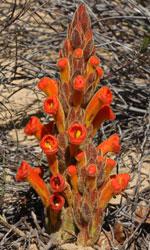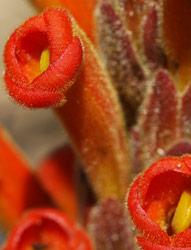Harveya squamosa
Harveya squamosa (Thunb.) Steud.
Family: Orobanchaceae
Common names: None recorded
Introduction
Harveya squamosa is a strange root parasite, commonly seen with the whole plant coloured a glorious red to orange or, rarely, all sulphur yellow, with no trace of green.

Description
Description
This plant is a perennial, parasitic herb ranging between 200 and 400 mm high. It is a total or holoparasite, lacking all chlorophyll. Hence it cannot photosynthesise and is fully dependent on its host for all its nutrients. It attaches itself to the roots of the host by means of a prominent, tuberous, vascular organ called a haustorium. Through this, it absorbs all it needs from the host. The stems are fleshy and usually simple but, rarely, there can be up to eight branches. This plant does not bear normal-looking leaves but the stems are covered in small, appressed, scale leaves. The whole plant, including the inflorescence, is usually one colour, deep carmine red to orange or rarely yellow. However, one illustration (Phillips 1922) shows the calyx and corolla tubes as yellow while the rest of the inflorescence is red. Several herbarium specimens also have notes mentioning yellow on the corolla tube.

The only portions of the plant that appear above ground are the top of the stem and the terminal inflorescence. This is a dense spike of 8 to 25 (rarely to 33) bisexual flowers. The corolla tube is narrow-cylindrical to -conical above the base, and a little curved. The five corolla lobes are short, entire and overlapping. The style bends downwards at the tip when the flower is ready for pollination. Then the club-shaped stigma is clearly visible as it emerges from the corolla. The flowering time ranges from August to December but is at its peak between September and November.

A variety of hosts has been recorded for Harveya squamosa, including Arctotis decurrens and Othonna leptodactyla (Asteraceae), as well as species of Aspalathus (Fabaceae), Cliffortia (Rosaceae), Ehrharta (Poaceae), Scirpus (Cyperaceae), and Willdenowia (Restionaceae).
Conservation Status
Status
Raimondo et al. , in the book "Red List of South African Plants 2009", gave the conservation status of Harveya squamosa as of "Least Concern". This means the species is not at risk of extinction or under threat.
Distribution and habitat
Distribution description
This parasite grows mainly in sandy soils along the west coast of South Africa, from a little north of Hondeklip Bay in the Namaqua National Park, Namaqualand, south to the Cape Peninsula. It can also be found as far east as Worcester. Recorded habitats include coastal sand dunes, low-lying sandy hillocks, and coastal fynbos. Once it was found on a steep slope in heavy clay, derived from Malmesbury shale. Altitudes range from 15 to 650 m.
Derivation of name and historical aspects
History
The name Harveya was given to this genus in 1837 by Sir William J. Hooker in honour of his long-time friend, William Henry Harvey (1811-1866), an Irish botanist who pioneered South African systematic botany. Harvey visited the Cape several times between 1835 and 1842 and was Treasurer-General at the Cape from 1836 to 1838. He seems to have done more botany than administrative work, arising early many mornings and going plant-hunting. Later he became a professor of Botany at Trinity College, Dublin, and we are indebted to him for several botanical works. These include the major part of the first three volumes of the Flora Capensis (Gunn & Codd 1981). He was very pleased with the naming of this parasitic genus after himself and he saw it as appropriate since "I am one of those weak characters that draw their pleasures from others, and their support and sustenance too" (quoted by Duncan 2010).
The genus Harveya occurs in Africa (mainly in southern Africa with isolated pockets elsewhere), Madagascar, the Comores and Yemen. It has c. 40 species of which 13 occur in the flora of the southern African region (Mabberley 2008 and Randle 2006). Plants in this genus can be either holoparasites, having no chlorophyll, or hemiparasites, with chlorophyll. All the southern African ones are of the former type. This genus was first placed in the Scrophulariaceae family but now, after molecular systematic studies, it is regarded as part of the Orobanchaceae (Fay et al , 2010).
Squamosa in Latin means covered in coarse scales, referring to the much reduced scale leaves. This species was originally named Orobanche squamosa by Thunberg in 1800, as it seemed to be related to that European parasitic genus. Harvey moved it to Aulaya in 1838, while Steudel placed it under Harveya in 1841.
Ecology
Ecology
The haustorium of Harveya causes the inner tissues of the host root to grow larger, and thus the two plants become closely connected. These parasites have large, sunken stomata that help set up fast transpiration. This aids the suction of nutrients from the host root. Many specimens of H. squamosa have an extensive underground rhizome. This may give it an advantage for living in loose and shifting sandy soil (Randle 2006). One herbarium specimen records that some flowers had been eaten by caterpillars.
A common feature of the genus Harveya was noted by Visser (1981). "One anther cell of each stamen is sterile and transformed into a spur to aid the shedding of pollen before the stigma blocks the way". Presumably the pollinator, by touching the spur, will help shake pollen out of the anther cell. The downward curve of the style leads to the stigma blocking the entrance to the corolla tube. This aids transfer of pollen from the pollinator to the stigma, as the pollinator pushes past.
Visser (1981) suggested that pollination of this Harveya is by birds because of the narrowly tubular, orange or red flowers, copious nectar and lack of scent. Further to this, the flowers are usually clearly visible, out in the open, not being hidden by other plants. However, there are no definite records of pollinators for this species. Perhaps ants, mice or sengis (elephant-shrews) are involved. The last two may not be very likely as the flowers do not seem to get damaged. In Mpumalanga, flowers of another root parasite, Cytinus visseri, are visited by other species of these small animals and are often broken slantwise (Smithies & Burgoyne, 2010). However, the latest paper about mouse and sengi pollination (Weston 2011) noted that the Cape species of these animals do not damage the flowers of Whiteheadia bifolia.

Uses
Use
No reports of uses or cultural aspects have been found.
Growing Harveya squamosa
Grow
Fay et al . (2010) reported that there is growing interest in cultivating parasitic plants. This is not only because they are strange and often beautiful, but also because many are in need of conservation, as they are threatened. However, growing parasites is complicated because the host has to be established first. Then seeds of the parasite have to germinate close by. In some cases exudates from the host roots stimulate germination of the parasite seeds.
There is one report of Harveya squamosa being more or less cultivated (Duncan 2010). In 1979 Prof. Niel du Plessis found flowers of this species near Blouberg, Western Cape. He sowed seed from these in 1980 under three large bushes of Othonna coronopifolia. These were in the Cape Flats Nature Reserve, where this parasite had not been found. For two years he kept visiting the bushes but nothing had happened. In 1983 he looked again and found three large colonies of Harveya squamosa under the bushes. Hence, to grow H. squamosa , follow Du Plessis's example: find or grow a suitable host plant in a loose, sandy soil; sow parasite seed close to the host, covering lightly with sand. Keep the soil moist and apply much patience. You may be lucky!
As the second author wrote, of Cytinus visseri , "Cultivation of these plants would be a challenge but well worth the effort, as these beautiful, rarely seen, fascinating flowers deserve to be better known" (Smithies & Burgoyne 2010).
References
- Duncan, G. 2010. Harveya purpurea . Curtis's Botanical Magazine 26,4: t. 664.
- Fay, M.F., Bennett, J.R., Dixon, K.W. & Christenhusz, M.J.M. 2010. Parasites, their relationships and the disintegration of Scrophulariaceae sensu lato . Curtis's Botanical Magazine 26,4: t. 286 -313.
- Gunn, M. & Codd, L.E. 1981. Botanical Exploration of southern Africa : 179-181. Balkema, Cape Town for the Botanical Research Institute.
- Mabberley, D.J. 2008. Mabberley's Plant-book. A portable dictionary of plants, their classification and use , edn 3: 392. Cambridge University Press, Cambridge.
- Phillips, E.P. 1922. Harveya squamosa . Flowering Plants of Southern Africa 2: t. 67.
- Raimondo, D., Von Staden, L. Foden, W., Victor, J.E., Helme, N.A. Turner, R.C. Kamundi, D.A. & Manyama, P.A. (eds). 2009. Red List of South African plants. 2009. Strelitzia 25: 617.
- Randle, C.P. 2006. Revision of Harveya (Orobanchaceae) of Southern Africa, Systematic Botany Monographs 80: 27-30.
- Smithies, S.J & Burgoyne, P.M. 2010. Cytinus visseri (Cytinaceae). Curtis's Botanical Magazine 26,4: t. 659.
- Visser, J. 1981. South African parasitic Flowering Plants . Juta, Cape Town and Johannesburg.
- Weston, P. 2011. Sticky snack for sengis. Veld and Flora 97,3: 112, 113
Credits
J. Ready & S.J. Smithies
National Herbarium Pretoria
October 2011
Plant Attributes:
Plant Type: Parasitic
SA Distribution: Western Cape
Soil type: Sandy
Flowering season: Spring, Early Summer
PH:
Flower colour: Red, Yellow, Orange
Aspect:
Gardening skill: Challenging
Special Features:
Horticultural zones








Rate this article
Article well written and informative
Rate this plant
Is this an interesting plant?
Login to add your Comment
Back to topNot registered yet? Click here to register.